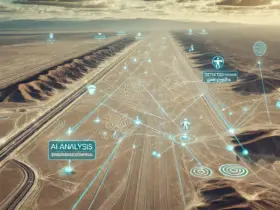Artificial intelligence (AI) is revolutionizing not only technical fields but also art. Moving beyond traditional art production methods, AI adds a new dimension to the creative process. In this article, we will explore how AI is used in art production, the most widely used AI models, and their impact on art. Additionally, we will provide examples of the most popular AI models for generating images, videos, and sounds, along with their distinguishing features.
Creating Art with Artificial Intelligence: Algorithms and Creativity
Artificial intelligence can create artworks using various algorithms and models. This process complements rather than replaces human creativity. AI learns different forms and styles of art by training on large datasets and uses this knowledge to generate unique, original artworks.
The most common AI models used in art production include Generative Adversarial Networks (GANs), Recurrent Neural Networks (RNNs), and Transformer models. Each of these models offers different approaches and capabilities in art production.
Generative Adversarial Networks (GANs)

GANs, introduced by Ian Goodfellow in 2014, have significantly impacted the AI field. GANs consist of two neural networks: a generator and a discriminator. The generator creates new data samples, while the discriminator attempts to determine whether these samples are real or fake. These two networks compete against each other, leading to highly realistic and creative results.
Features:
- High Realism: GANs can produce extremely realistic images, sometimes indistinguishable from real photographs.
- Style Transfer: GANs can apply an artist’s style to another image. For example, they can transform a modern photograph into a painting in the style of Van Gogh.
DeepArt
DeepArt uses deep learning techniques to transform photographs into artworks. This model is particularly used for style transfer, applying an artist’s style to an existing image.
Features:
- Style Transfer: DeepArt can successfully apply a specific artist’s style to an existing image.
- Ease of Use: Users can easily create their own artworks without any technical knowledge.
AI Models for Generating Videos

DALL-E 2
DALL-E 2, developed by OpenAI, is an AI model that can generate images and short videos using natural language descriptions. This model combines the language processing capabilities of GPT-3 with image generation.
Features:
- Natural Language Descriptions: DALL-E 2 can create images and videos based on written descriptions provided by users.
- Creativity: The model can produce unexpected and creative results, offering great flexibility for artists and content creators.
Runway ML
Runway ML is another popular AI tool used for video and visual content production. This platform allows users to easily create videos using AI models.
Features:
- User-Friendly: Runway ML provides a user-friendly interface, allowing users to utilize AI models without technical expertise.
- Variety of Models: The platform supports different AI models, enabling users to apply various artistic effects and styles.
AI Models for Generating Sounds

OpenAI Jukebox
OpenAI Jukebox is an AI model capable of generating songs in various music genres. This model is trained on a large dataset of music and can create new music pieces in the style of specific artists.
Features:
- Variety of Styles and Genres: Jukebox can produce songs in different music genres and artist styles.
- Realistic Sounds: The model can generate realistic vocals and instrumentals, making it useful in music production.
Google Magenta
Google Magenta is a project focused on using AI in the creative process for producing music and art. Magenta utilizes various AI models to create music and visual art pieces.
Features:
- Versatility: Magenta can generate a wide range of content, from music to visual art.
- Open Source: The project is open-source, allowing developers and artists to create their own AI models and projects.
Distinguishing Features of the Models
- GANs vs. DeepArt: GANs stand out with their high realism and style transfer capabilities, while DeepArt offers ease of use and a user-friendly interface.
- DALL-E 2 vs. Runway ML: DALL-E 2 uses natural language descriptions to produce creative and unexpected results, whereas Runway ML is known for its ease of use and support for various AI models.
- OpenAI Jukebox vs. Google Magenta: OpenAI Jukebox generates realistic music in specific artists’ styles, while Google Magenta provides a wide range of creative content and flexibility for developers with its open-source nature.
Conclusion
Artificial intelligence offers unprecedented opportunities in art production. Models like GANs, DALL-E 2, OpenAI Jukebox, and others provide new tools and techniques for artists to expand their creativity. The unique features and capabilities of these models indicate that AI will continue to revolutionize the art world. AI in art production redefines the nature and creative process of art. Models like GANs, RNNs, and Transformers offer new tools and techniques for artists to broaden their creativity. AI plays a complementary role to human creativity, allowing artists to create unique and original works. The impact of AI on art will become even more pronounced in the future, continuing to revolutionize the art world.











Leave a Reply